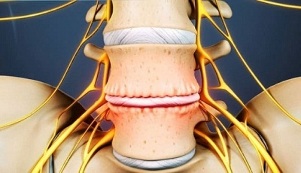Timely treatment of the disease can increase the chances of a quick and successful recovery. But in any case, it is better to prevent the development of a disease, especially one as severe as osteochondrosis of the neck.
Definition of cervical osteochondrosis

Osteochondrosis of the neck is a fairly common disease that has been affecting younger people more and more recently. The disease affects the intervertebral plates of the cervical spine. Often, the pathological process of degenerative-dystrophic changes is facilitated by improper posture, such as long work on a computer.
Among other things, the problem can be caused by genetic predisposition, poor posture, uncomfortable sleeping, and a sedentary lifestyle. Although this type of osteochondrosis develops rather slowly, it tends to progress.
In elderly patients, this disease is mainly combined with other degenerative processes, such as:
- interspinous arthrosis; spondylosis;
- uncovertebral arthrosis and so on.
Symptoms
As for the most common symptoms, first of all, the appearance of acute pain due to the tightening of nerve endings can be observed. The pain is often concentrated in the lumbar, cervical and posterior areas. You may also find additional syndromes:
- Cardiac Syndrome- consists of a number of symptoms that are similar to angina pectoris. This syndrome develops during irritation of the roots of the pectoralis major muscle or the frrenic nerve. Because of this, a person experiences depressive painful feelings in the area of the heart muscle that can occur intermittently and continue for several hours. Sneezing or sudden head movements often aggravate the pain. Moreover, no change in the cardiogram was detected during painful seizures;
- radical syndrome- occurs when nerve endings become pinched in the cervical spine. At this moment, there is pain that can be given not only to the forearm, shoulder, or shoulder blade, but also to the lumbar region. The patient may experience mild tingling or more pronounced feelings, depending on how much osteochondrosis begins;
- irritant-reflex syndrome- occurs with a burning sensation in the neck and neck. Such symptoms often occur after waking up from sleep, with sharp dizziness, coughing, and sneezing. Moreover, the pain may manifest not only in the shoulder area but also in the chest area;
- Vertebral Artery Syndromeis a typical manifestation of the disease characterized by the occurrence of a burning or throbbing headache that is better localized in the temporal or occipital region. Often with this syndrome, constant pain occurs, but sometimes it can arise and subside.
Listen!In the presence of symptoms of cervical osteochondrosis, specialists find increased fatigue in a person, which can cause hearing and vision impairment.

As for the other main symptoms of the disease, these are:
- Compression of blood vessels causing an increase in blood pressure;
- is a severe headache caused by a disorder of the blood flow to the brain. This type of pain can cause the patient to use painkillers on a regular basis;
- vision and hearing problems;
- painful, rather severe pain in the neck and shoulders, which can sometimes be aggravated by a sharp and very unpleasant "lumbago";
- grinding and crunching when tilting the head or turning to the side;
- Decreased muscle strength in the arms due to chest pain;
- dizziness.
Important!As soon as the first symptoms of the disease are detected, help should be sought from a neurologist as soon as possible.
Causes
The main causes of osteochondrosis are:
- Metabolic disorders that adversely affect the normal state of cartilage in the intervertebral discs.
- Insufficient motility of the cervical vertebrae, resulting in fluid loss, which in turn negatively affects cartilage elasticity.
- Microtrauma of the cervical spine, tilting of the head, turning, etc.
- Weak inheritance, which makes the disk backup very small.
Management
The therapeutic process depends directly on the stage of the disease and is based on an integrated approach. The treatment lasts on average 1-3 months, after which it is necessary to support the elimination of symptoms with preventive measures for about 1 year.
The main treatment is carried out in two directions, depending on the patient's state of health and the degree of neglect of the disease. As for conservative treatment, this includes taking medications and exercising. Treatment using surgery is performed only if the conservative has not given any effect.
Conservative treatment withIt is importantto follow a diet and follow recommendations for therapeutic practices.
is intended to relieve pain, restore and normalize spinal function, and prevent adverse changes. A whole range of therapeutic measures are used in such therapies:

- spine traction (traction). Using special medical equipment, the spine is stretched to increase the distance between the vertebrae;
- Medication. The use of drugs during this disease is primarily aimed at relieving pain, relieving inflammation, and generally normalizing metabolic processes in the body;
- physiotherapy. Thanks to such procedures, it is possible not only to reduce pain, but also to improve the effect of medication. Such methods are also used during the rehabilitation period. In this case, laser beams, ultrasonic waves, low frequency currents, working with magnetic fields, etc. are often used.
- kinesitherapyand exercise-based exercise;
- manual therapy. Such treatment is chosen individually for each patient;
- massage. Thanks to the massage, you can speed up the blood circulation of the tissues, remove the clamps and muscle cramps, and usually improve the blood supply to the tissues of the whole body.
Although drugs alone cannot cure osteochondrosis, they can help restore tissue blood supply. Therapy should be comprehensive, only then can we talk about the effectiveness of treatment. In addition to taking medications, it is essential to take physical therapy, follow a diet, and give up bad habits.
In the absence of pain or marked dystrophic changes, over-the-counter medications are inappropriate. The following types of medications are used to treat this disease and relieve pain:
- Devices for the prevention of regeneration and degeneration of cartilage tissue: hyaluronic acid and its analogues;
- to relieve inflammation;
- preparations to improve tissue blood supply: B vitamins;
- antispasmodics;
- Antioxidants: Vitamins N, E and C

Medicines can be prescribed not only as tablets and capsules orally, but also as injections or topical ointments / creams. If there are acute complications, medications are used to block nerve endings.
Along with medication, it is very important to maintain a healthy lifestyle and proper nutrition. Drink at least 1, 5 liters of water a day.
One and a half liters of water a day is the recommended norm for the health of the joints and the whole body.
Of course, you can also use herbal teas, fruit drinks, dried fruit compotes or mineral water. Coffee, strong black tea, alcohol and carbonated beverages should be excluded from the daily diet.
Prevention
The main causes of osteochondrosis are neglect of the body’s requirements, high loads and poor nutrition. Therefore, prevention should be based on the complete elimination of negative effects on the spine and the prevention of pathological changes. To this end, it is sufficient to follow the usual rules of a healthy lifestyle (healthy lifestyle):
- only moderate physical activity during sports: morning exercise, gymnastics, athletics, if wrestling, then contactless swimming is an excellent option;
- When staying in a position for a long time, such as sitting, it is very important to take breaks at least every 45-60 minutes. During this period, you should give your body 5-15 minutes for a little warm up, which will restore normal blood circulation. In addition, it is very important to pay attention to the correct choice of office chairs or armchairs, giving preference to those that support the spine, check the correct position of the hands at the table and the feet on the floor. Try to monitor your posture on your own (shoulders should be relaxed and back should be straight);
- It is important to try to control your emotion in the event that a spasmodic reaction occurs during stress. To this end, you should learn relaxation techniques and systematically participate in massage to strengthen the body in general;
- For sleep, it is best to choose a flat orthopedic mattress. Of course, it won’t be as soft as a feather bed, but its flexibility ensures the body is in the right position;
- Eating lots of water and eating right will not only help maintain your metabolism, but also strengthen your whole body:

Mental condition also negatively affects the condition of joints.
- When you need to move or lift heavy things, it is very important to do it as simply as possible, from a semi-squat position, without sudden shocks and jerks. There will be no need to use a special support belt;
- An important consideration is to choose high-quality orthopedic shoes without high heels with the right foot width. Replacing worn shoes in a timely manner can also reduce spinal strain, which is especially important for women. In summer, at the dacha, by the sea, if possible, walk barefoot on different surfaces, thereby strengthening the leg muscles.
It is important to notethat prevention is much better and easier than treating the disease later.
Exercises
Under no circumstances should you start physical activity and exercise without a doctor's prescription or before relieving your pain syndrome. The specialist should first relieve the acute symptoms. In the presence of symptoms of pain, gymnastics will be painful.
There are some really effective and simple exercises. They can be done not only at home, but anywhere, including work or even on the road.
In each case, start the exercise with the initial posture while sitting on a chair and kneeling:
It's a good idea to start with a warm-up:
- In the starting position, slowly turn your head to one side until it stops, then to the other. At this moment, you need to feel how the muscles in your neck stretch. Once the neck is fully turned to one side, you should turn it a few more degrees as carefully as possible, avoiding sudden movements, and lock it in this position for 5 seconds. Experts recommend starting all exercises with a warm-up to strengthen the neck muscles. It is enough to perform 5 turns in each direction to improve the strength and flexibility of the neck.
- You will then need to tilt your head so that the ear approaches the shoulder. It is worth noting that at this point the shoulder should remain motionless. At the maximum approach, you need to confirm the position. Make sure that the operations do not cause discomfort or pain. It is sufficient to make such bends five times on both sides.

Then continue with the main exercises:
- Now that you have finished warming up, you can move on to specific exercises that can produce good results. In the starting position, you should rest your hand on the right temple. Now you have to try to tilt your head to the right, and your hand should prevent that at this moment. The effort should be such that it is difficult, but the head is still gradually leaning in that direction. 10 slopes on each side will suffice. Of course, the hand also needs to change.
- You should then grab the occipital region of the head and create resistance and try to tilt the head back five times.
- Exactly the same exercise should be performed even if the palm rests on the forehead. Through the resistance, you have to pull your chin to your chest. 5 will be enough to lean forward.
- Closing a workout can be warming up the traps, which is done by lowering and raising the shoulders. You need to close at the highest point for a few seconds, then lower them and relax completely. Enough for 10 reps.
- Complete the exercise by stretching the neck in different directions. This series of exercises should be done every day. This is a great option for neck warming in osteochondrosis.
In addition to strength training, neck flexibility exercises can also be involved. They strengthen not only the muscles of the neck but also the tendons. Warming up makes your neck more mobile.
Exercises are recommended by professionals not only for osteochondrosis of the cervical spine, but also for all people over 30 years of age. The problem is that at this age, muscle fibers lose their elasticity, so it is important to maintain them along with the overall health of the body.
- Your chin should be pulled to your chest and at this point your head should be helped with your hands.
- Very carefully, you need to tilt your head sideways with your hands to touch your shoulders with your ears.
Only proper treatment of the first symptoms of osteochondrosis will allow you to cope with this problem as quickly as possible and return to a normal life without pain and discomfort.
Then the head must make several circular movements in one direction and then in the other. 8 turns on each side will suffice. The exercise should be done very carefully. For safety reasons, you can hold your hand.


















































